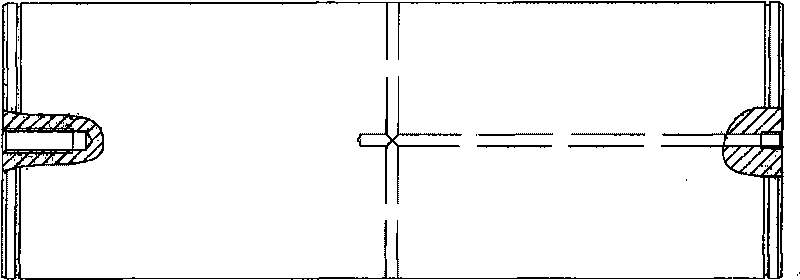Method for manufacturing pin shaft through forging
A pin-to-forging ratio technology, applied in the forging field, can solve the problems of failure to meet standards, very high pin performance requirements, and inability to achieve localization, so as to meet technical requirements and improve reliability
- Summary
- Abstract
- Description
- Claims
- Application Information
AI Technical Summary
Problems solved by technology
Method used
Image
Examples
Embodiment 1
[0027] Embodiment 1: the requirement of manufacturing process among the present embodiment is:
[0028] 1. Material selection:
[0029] Choose 12" square ingot, the chemical composition of the 12" square ingot should meet the following requirements:
[0030] 0.37%≤C≤0.44%, trace ≤Si≤0.35%, 0.70%≤Mn≤0.90%, trace ≤P≤0.025%, trace ≤S≤0.025%, 0.70%≤Cr≤0.95%, 0.30% ≤Mo≤0.40%, 1.60%≤Ni≤2.00%, trace ≤Cu≤0.20%, the balance is Fe and unavoidable impurities.
[0031] 2. Forging:
[0032] Cutting percentage of ingot head and ingot tail: 13% of steel ingot cutting head and 5% of tail cutting.
[0033] 1) Heating the steel ingot to 800°C, holding it for 2 hours, then heating it for 3 hours to make the temperature reach 1180°C, holding it for 1.5 hours and pulling out the billet;
[0034] 2) Heating the workpiece to 1180°C, and performing elongation-upsetting, and then rounding, straightening, and correcting the dimensions so that the forging ratio is not less than 4, so as to forge the...
Embodiment 2
[0046] Embodiment 2: the requirement of manufacturing process among the present embodiment is:
[0047] 1. Material selection:
[0048] Choose 12" square ingot, the chemical composition of the 12" square ingot should meet the following requirements:
[0049] 0.37%≤C≤0.44%, trace ≤Si≤0.35%, 0.70%≤Mn≤0.90%, trace ≤P≤0.025%, trace ≤S≤0.025%, 0.70%≤Cr≤0.95%, 0.30% ≤Mo≤0.40%, 1.60%≤Ni≤2.00%, trace ≤Cu≤0.20%, the balance is Fe and unavoidable impurities.
[0050] 2. Forging:
[0051] Cutting percentage of ingot head and ingot tail: 13% of steel ingot cutting head and 5% of tail cutting.
[0052] 1) Heating the steel ingot to 800°C, holding it for 2 hours, then heating it for 3 hours to make the temperature reach 1180°C, holding it for 1.5 hours and pulling out the billet;
[0053] 2) Heating the workpiece to 1180°C, and performing elongation-upsetting, and then rounding, straightening, and correcting the dimensions so that the forging ratio is not less than 4, so as to forge the...
Embodiment 3
[0065] Embodiment 3: the requirement of manufacturing process among the present embodiment is:
[0066] 1. Material selection:
[0067] Choose 12" square ingot, the chemical composition of the 12" square ingot should meet the following requirements:
[0068] 0.37%≤C≤0.44%, trace ≤Si≤0.35%, 0.70%≤Mn≤0.90%, trace ≤P≤0.025%, trace ≤S≤0.025%, 0.70%≤Cr≤0.95%, 0.30% ≤Mo≤0.40%, 1.60%≤Ni≤2.00%, trace ≤Cu≤0.20%, the balance is Fe and unavoidable impurities.
[0069] 2. Forging:
[0070] Cutting percentage of ingot head and ingot tail: 13% of steel ingot cutting head and 5% of tail cutting.
[0071] 1) Heating the steel ingot to 800°C, holding it for 2 hours, then heating it for 3 hours to make the temperature reach 1180°C, holding it for 1.5 hours and pulling out the billet;
[0072] 2) Heating the workpiece to 1180°C, and performing elongation-upsetting, and then rounding, straightening, and correcting the dimensions so that the forging ratio is not less than 4, so as to forge the...
PUM
| Property | Measurement | Unit |
|---|---|---|
| length | aaaaa | aaaaa |
| diameter | aaaaa | aaaaa |
Abstract
Description
Claims
Application Information
 Login to View More
Login to View More - R&D
- Intellectual Property
- Life Sciences
- Materials
- Tech Scout
- Unparalleled Data Quality
- Higher Quality Content
- 60% Fewer Hallucinations
Browse by: Latest US Patents, China's latest patents, Technical Efficacy Thesaurus, Application Domain, Technology Topic, Popular Technical Reports.
© 2025 PatSnap. All rights reserved.Legal|Privacy policy|Modern Slavery Act Transparency Statement|Sitemap|About US| Contact US: help@patsnap.com


